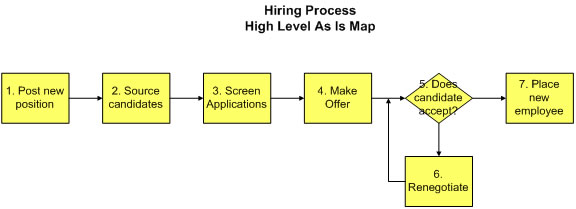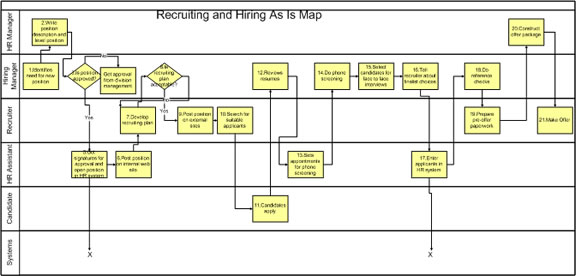Corporations track specific financial measures, use operational measures to monitor their core business, and collect some customer satisfaction measures. However, as companies move to a more process-centric approach they need to think about measures for each process and sub process, and these are often not captured today.
One company I worked with had over 400 operational measures but very few process measures. They began with a system wide top down approach, modeling the eight core processes of the enterprise (level one processes) and several level two processes within each of those eight core processes. They defined the goals of each level one and level two process and then identified measures that would show how they performed against that goal. Clearly, this is a comprehensive approach. But when I worked with some of these process owners six to nine months later I found that many groups were not tracking these measures. So far, the process measures had been a business process management exercise; they were still only tracking the financial and operational measures.
So where do you begin? I have found that selecting a few measures and really capturing them and monitoring them is the best way to start. Start small, and use the measures.
The overriding reason to measure is to make decisions and take action. Measures provide you the quantitative data to make decisions objectively. So carefully consider who wants the measure in the organization and what he/she will do with the measure once they know it. In fact, ask that decision maker to articulate what action he/she will take and if that person doesn’t know, don’t start measuring.
You can measure against history, forecast, competitors, or best practices. Measures enable you to see trends. Analysis can determine if a measure is an outlier, a special cause or not. I suggest measuring in three areas to start:
- To understand the health of the process
- To signal early if the process is on track
- To identify the extent of the gaps between current state and desired state
Let’s take an example to see how to select and capture measures in reality. I will use the Hiring process.
Begin with the big picture – relate the process to organization’s strategy and determine what the improvement targets are. I use a high-level map that is shown below. You could also use the SIPOC (Supplier, Inputs, Process, Outputs, Customer) model from Six Sigma or the Value Stream Map from Lean.)
 |
The external consultant (or internal facilitator), process sponsor, and project lead develop the high-level map. It sets the scope, helps identify who should be on the team, and identifies the sponsor’s improvement targets. The improvement targets articulate the sponsor’s goals for the project. There should only be one or two improvement targets and they need to be quantifiable. Here’s your first chance for measures!
In the Hiring Process, the sponsor was the Chief Human Resources Officer for the organization. She stated the current hiring challenges: “We have 4 different divisions with business units under them. And right now, we have 15 different recruiting processes. Then she articulated two improvement targets:
Improvement Target #1: Standardize the recruiting process for our organization.
Improvement Target #2: Make the process more efficient.
The first target is quantifiable. It implies we want one standard process- not 15 (there’s a current measure too) for doing recruiting in the organization.” But the second target is not yet quantified. Here’s where we need to get some data. We decided to use ‘Time to job fill ‘or the time from the initial request to when a candidate is hired. The sponsor also wanted to reduce the amount of paperwork in the system, so we noted each place where there was paper or re-entry from paper into the system. There were 22 different checklists (some were for different information and others were different formats of similar information in different units), reentry of information from paper occurred at three key places in the process- candidate information from the request, when they entered from any recruiting site, and a third time when they were accepted or rejected by the hiring manager. These can be identified by step once you do the more detailed swim lane map.
At this initial stage of the process, you may need to develop a business case, because you want the sponsor and corporation to take action to pay attention and improve this process. So benchmark your process against other industries or competitors and find out what the best practice numbers are. Then communicate the gap between your numbers and other organizations. In this case, “Time to job fill’ would make for a good comparison.
 |
The next step in your process improvement effort is to select the team that will work on the project and have them meet and create a current state map, the As Is process for the Hiring Process. In this case example, since the client had so many different ways of doing Hiring in the different units, we did many different instances of Hiring As Is maps , one or more from each unit. We looked at instances by unit, and by different type of hire (from researcher, to student intern, to computer analyst, or human resources generalist.)
Now they were ready to think about measures. Initially we began very simply as I am suggesting you do. We identified measures for time, efficiency and customer satisfaction as follows:
| Category/ type of measure | In process (signals early detection) |
Output ( health of process) | Gap |
| Timeliness | Time from job identification to external job posting | Time to fill job | % candidates over average time to fill job |
| Efficiency | New job openings per month per unit | Candidates per recruiter per month | Range from highest to lowest of candidates per recruiter per month |
| Customer Satisfaction | % candidates meeting hiring manager’s spec at resume review | % candidates hired from final 3 candidates ( vs. starting over) | Nothing defined |
What started happening is that recruiters, hiring managers, and HR directors began quoting current measures, discussing them with hiring managers, and working to improve them. Identifying the measures and tracking them begins that discussion and suggests some actionable improvements.
The Art, Science and Politics of Measures
The art of measures begins simply with coming up with the measures –selecting the right ones and anticipating how the measure will work in practice. You want to select an output measure, an in process measure and a gap identifying measure, but you may not know which measure will be the most meaningful when you start. So pick one of each, start tracking it, see what you learn, and take action. If the measure does not track what you want or has an unintended behavioral effect, change it and track another. You may choose the wrong measures to start ( that’s why it is an art), but if your measures create provocative dialog you made a good beginning.
The science of measures means applying rigor, methodology and accepted standards to your measures. This is a goal, and will not be where you start. Use the three measurement areas suggested, refine selected measures, and move useful measures from manual to automated; use the measures in analysis to learn and take action. Once you are able to establish acceptable ranges for different measures, your measures will tell you whether you process is healthy or not, determining if you need to take any action or not.
The politics of measures is knowing how measures will galvanize or threaten individuals in the organization. How should you introduce measures into the organization in a way that moves your effort forward? Who will be threatened by measures? Measures from the customer are less volatile politically than measures about a specific business unit or function. Comparative benchmark measures may make a strong business case, but they could imply job loss for employees or departments. Many people view measures as evaluative of their performance, vs. objective data about the current state. It takes time to see measures as a way to get data points, make change, and then see trends. So communicate thoughtfully when measures are first introduced and keep the focus on the improving business processes instead of ‘holding people accountable.”
Conclusion
Start with a few process measures that track the health of the process, signal early detection of success or difficulty, and show performance gaps. And, as you identify these measures know there is an art to finding useful measures and a politics to introducing them. So keep you eye on the focus: what action will I take when I see this measure?

















